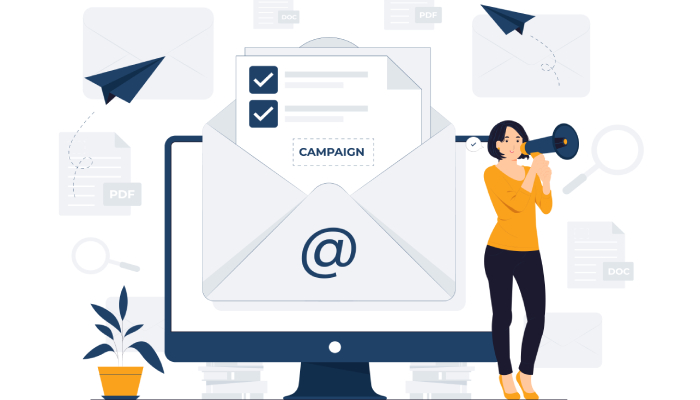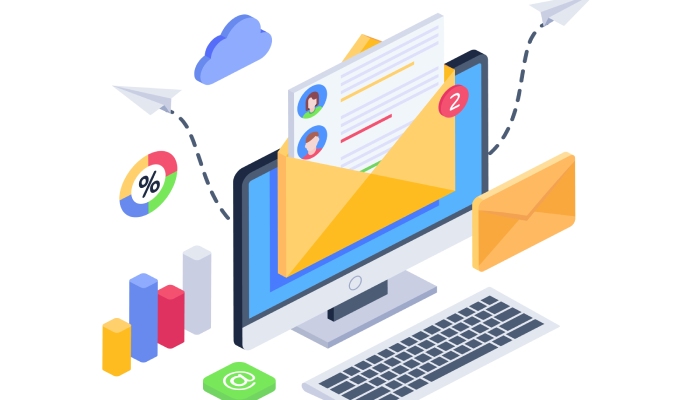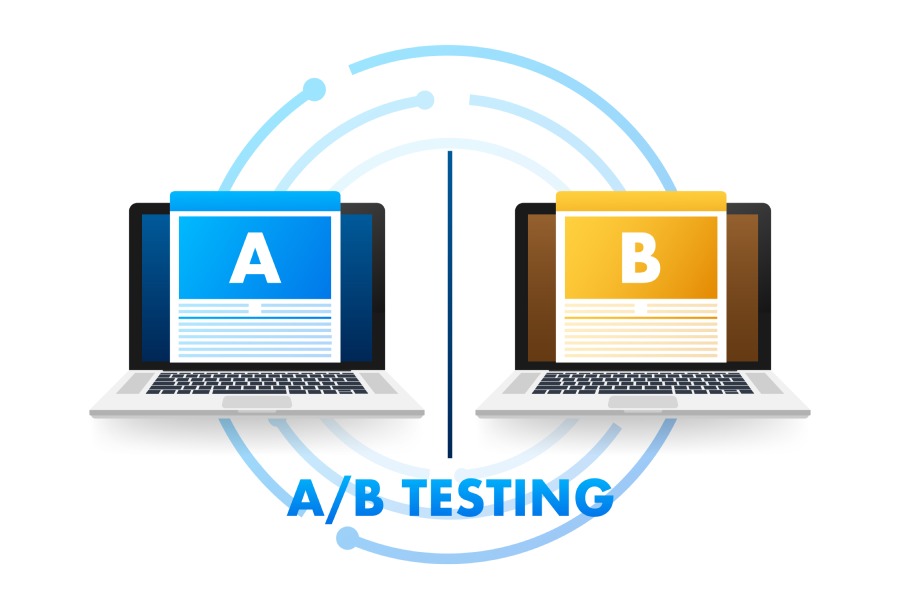A/B Email Testing: Improve Your Email Campaign Results with These Tips.
Email marketing remains one of the most effective ways to connect with customers, but not all emails hit the mark. Have you ever wondered why some email campaigns soar while others flop? The answer often lies in A/B testing. This simple yet powerful technique lets you discover what engages your audience, turning trial and error into informed decisions.
Imagine being able to directly compare different subject lines or button colors to see which gets more clicks. It’s like tuning a radio until the music comes in perfectly clear! In this article, we’ll explore straightforward tips and strategies that can elevate your email campaigns, ensuring they get noticed and drive action. Let’s dive in!
A/B email testing is a method used to compare two versions of an email to determine which one performs better based on engagement metrics such as open rates and click-through rates. This testing is crucial for optimizing email campaigns because it relies on data-driven results, enabling marketers to make informed decisions that can enhance overall engagement and conversion rates.
Choosing Your A/B Testing Variables

When embarking on an A/B testing journey, it’s essential to pinpoint which elements could make a difference in your results. By concentrating on variables that have proven impacts, you can maximize the effectiveness of your campaigns.
For instance, let’s take a closer look at subject lines. Subject lines are often the first, and possibly most critical, interaction a recipient has with your email; they set the stage for engagement. It’s an intriguing realization: A staggering 33% of recipients open emails solely based on the subject line! To harness this knowledge, consider experimenting with different lengths or personalization techniques in your subject lines.
For example, you might test a subject line like “Exclusive Offer Just for You!” against a slightly different one such as “Don’t Miss This Exclusive Offer!” Such slight variations can effectively reveal how wording influences open rates. Being mindful of emotional appeal and urgency can significantly impact how recipients react.
Beyond subject lines, another crucial element that deserves attention is the call-to-action (CTA). Your CTA plays a pivotal role in guiding users towards the next steps you want them to take.
CTA Button Color and Text
The color of your CTA button may seem like a minor detail but its effects can be quite significant. Studies have shown that changing the color of a CTA button—like switching from blue to red—can increase click-through rates by as much as 21%. But it doesn’t stop at color alone; the words you use in your CTA also matter immensely. Altering text from “Shop Now” to something more engaging like “Grab Yours Today” can create a stronger sense of urgency and lead to higher conversions. As highlighted by Email Marketing Daily in a recent study, these seemingly simple adjustments can have profound implications on user behavior.
As you explore other potential variables for testing, think outside the box. Remember that every element from images to email layouts can influence reader engagement.
Popular Variables to Test
Consider testing different types of content, such as ebooks versus videos, or varying the formatting style—altering between short paragraphs and bullet points—to determine what resonates better with your audience. Personalizing sender names by using individual recipient names rather than generic department titles can also spark interest and enhance engagement rates.
Ultimately, each variable you select should align with your campaign’s goals while being relevant to your audience’s preferences and behaviors. By systematically choosing and testing these variables, you’ll develop insightful data that can refine your overall email strategy.
With these foundational elements in mind, it becomes essential to focus on crafting variations that not only attract attention but also drive action among your audience.
Designing Effective Email Variations

Crafting your variations is about more than mere content; it encompasses the overall experience you’re delivering to your audience. Imagine receiving an email that looks professional and cohesive, guiding you effortlessly toward the call to action. Here’s how you can achieve that and ensure your A/B testing is informative and fruitful.
Consistent Design With Variable Changes
One of the golden rules of A/B testing is to maintain a consistent design across both versions, excluding only the variable you’re testing. This way, you’ll clearly see how changes impact user engagement. For instance, if you’re experimenting with subject lines, keep every other factor—like email body content, images, and layout—exactly the same. This consistency will allow you to attribute any differences in performance directly to the subject line change alone.
To further underscore this importance, consider how even minor tweaks in formatting can lead to skewed results. If one email has a bright yellow button while another uses a faded gray button, any ensuing discrepancy in click rates could mislead you into thinking it’s due to the subject line when it may instead stem from contrasting visual cues.
Visual Appeal
Clearly, visuals matter greatly in emails! The layout and graphics play essential roles in capturing attention and encouraging engagement. Utilize professionally designed templates or online tools like Canva to create aesthetically pleasing email designs. These resources help ensure consistency in font styles, colors, and overall presentation.
Moreover, a well-crafted visual appeal reduces unsubscribe rates and boosts clicks—even when variations focus on non-visual elements. It’s staggering how an attractive email design can evoke a sense of professionalism and trustworthiness, inviting readers to explore rather than dismissing the communication at a glance.
As you put together these components, remember that sometimes simplicity reigns supreme. Stripped-down designs often mimic personal messages from a friend or family member more closely. So consider employing the KISS principle—Keep It Simple, Stupid—to enhance user experience without overwhelming your audience.
Now that you’ve established a solid design and grasped the importance of visual appeal, let’s navigate towards strategizing implementations that connect directly with your email’s objectives and key performance indicators.
Implementing Test Emails

Sending those test emails is more than just hitting the ‘send’ button. It requires careful consideration of your audience, timing, and content to ensure that you gather accurate and actionable data. This journey starts with the recognition that every element contributes to the success of your campaigns.
Using Specialized Tools
Platforms like HubSpot and Mailchimp simplify the process of A/B testing exponentially. Picture this: you have a perfect email crafted, but before launching it into the world, you want to know which version resonates best with your audience. By using these specialized tools, you can easily split your email list into two segments—sending variation A to one segment and variation B to another. This way, you can directly compare how each version performs based on engagement metrics such as open rates and click-through rates.
Additionally, keep an eye out for evolving features or integrations that may help streamline this process further.
Setting Up Timing and Frequency
Timing plays a crucial role in how your emails are received. To avoid skewing your results due to timing differences, ensure that both variations are sent at precisely the same time. For instance, if you’re targeting recipients during peak hours, sending both emails together provides a more accurate reflection of their respective performances under similar conditions.
| Variable | Tool | Action |
| Subject Line | Mailchimp | Create A/B Campaigns |
| CTA Buttons | HubSpot | Split List Feature |
Understanding your audience’s behavior is also essential; some may be more responsive early in the morning, while others may prefer late-night engagements. Therefore, consider conducting preliminary explorations using available analytics tools to identify favorable send times specific to your demographic.
Workflow Automation
Once you’ve done that groundwork, implement automated workflows that facilitate not only the sending of your emails but also manage their progress through tracking interactions over time. This workflow automation gives you the power to measure performance systematically and ensures that no data point gets overlooked. As engagements roll in, analyze them using insights provided by your selected platform—this streamlines real-time adjustments for ongoing campaigns.
With established workflows in place, the next step involves pinpointing the right audience to ensure your email campaigns hit home with maximum impact.
Selecting Your Target Audience

The effectiveness of your email campaign relies heavily on understanding who you are communicating with. By carefully selecting your target audience, you’re not just casting a wide net but steering your message toward those more likely to engage with it. This allows your campaigns to be more relevant and meaningful.
Imagine sending an enticing promotional email for winter gear to someone in a tropical climate—it’s unlikely that they will engage. Instead, honing in on recipients who fit specific demographics or behavioral patterns can vastly improve engagement metrics.
Audience Segmentation
Segmenting your audience is a crucial step that involves breaking down your subscriber list into groups based on shared characteristics. This can include demographics like age and gender, as well as behavioral factors such as past purchases or engagement history. For example, if you notice that a segment of your subscribers consistently clicks on links related to men’s fashion, tailor your subject lines and content specifically to them. This targeted approach helps ensure the messaging resonates, thereby increasing the likelihood of opens and clicks.
Moreover, considering the past behavior of your subscribers can yield valuable insights. If you have a group that has not engaged recently, it might be worth testing different subject lines or content styles to re-capture their interest. You could even compare responses in seasoned subscribers against newer ones; both might appreciate distinct types of content based on their experiences.
Sample Size
One cannot underestimate the significance of an adequate sample size for accurate analysis. Generally, each segment should encompass at least 1,000 subscribers to yield statistically valid results. Without hitting this mark, any conclusions drawn from small numbers can lead to erroneous decisions. When in doubt about your sample size, remember this: larger segments provide more reliable data because they help minimize variation caused by random chance.
Randomized Sampling
An important point of discussion arises around sampling techniques: randomized versus stratified sampling. Randomized sampling is often praised for its simplicity and fairness—it gives every member of the population an equal chance to be included in the sample. Conversely, stratified sampling focuses on ensuring representation from specific subgroups within the audience, potentially leading to richer insights tailored for targeted campaigns.
According to a recent study published in the Marketing Science Journal (2023), randomized sampling tends to work best for generalized tests where the goal is broad appeal. In contrast, stratified sampling shines through when tailored messaging is necessary; it crafts a narrative that considers different audience segments simultaneously.
With a well-defined audience and effective sampling techniques applied, you’re now positioned to turn your attention toward examining results and metrics that will inform future strategies.
Analyzing Results and Metrics

Careful analysis ensures that you learn the right lessons from your A/B tests. One of the fundamental aspects is to keep a close eye on key metrics that can inform your next steps. Understanding what works and what doesn’t can make or break your email marketing campaign.
Key Metrics to Monitor
Your primary focus should be on essential metrics which shine a light on different dimensions of performance. For instance, open rates are vital for gauging how well your subject lines grab attention—did they entice recipients enough to check out the email? Next in line, click-through rates (CTR) offer insight into whether your call-to-action (CTA) effectively encouraged readers to engage further with your content. Finally, conversion rates reveal how many engaged readers took the intended action, such as signing up for a webinar or making a purchase.
These metrics provide an excellent lens through which to view your campaigns. As of 2025, the average open rate stands at 19.21%, while the click-through rate averages around 2.44%. These statistics serve as benchmarks—use them as yardsticks against which to measure your campaigns.
Now that we understand which metrics to focus on, let’s explore how to visualize this data effectively.
Data Tools
Utilizing data visualization tools can significantly enhance the way you analyze campaign performance by allowing you to digest large amounts of information quickly and efficiently. Some popular tools include Google Data Studio and Tableau, both of which offer intuitive interfaces to create visual dashboards based on the data you track.
To ensure you’re getting comprehensive insights from these tools, be certain you monitor:
- Open Rate: Percent of recipients who opened the email.
- Click-Through Rate: Percentage of recipients who clicked a link within the email.
- Conversion Rate: Percentage of users who completed the desired action after clicking through.
This structured approach enables more informed decisions when strategizing future campaigns and helps eliminate guesswork.
However, analyzing data isn’t enough—you need to ensure your findings are statistically significant.
Statistical Significance
Statistical significance is crucial for interpreting test results accurately; achieving significance usually requires meeting specific criteria, such as a p-value less than 0.05. If your results don’t hit this metric, it’s difficult to distinguish whether the shifts observed were due to actual changes in response or simply due to random chance. Utilizing larger sample sizes when conducting A/B tests is essential, as smaller groups often lead to misleading results.
By systematically approaching A/B testing with these analytical insights, you’re taking significant strides toward improving your email marketing strategies. Armed with these insights, you’re not just guessing anymore; you’re equipped with real data that informs effective campaign optimization ahead.
With a solid understanding of your findings and next steps laid out, let’s now look into ways of enhancing your ongoing campaigns for improved efficiency and success.
Optimizing Future Campaigns

The key to improving email campaign results lies in harnessing the power of insights gathered from your previous testing. A/B testing isn’t just a one-time event; it’s an ongoing commitment to fine-tuning your approach based on data you’ve collected. This iterative cycle enables you to refine every element of your email, ensuring that each campaign is better than the last. Imagine crafting emails that resonate deeply with your audience because you’ve tailored them precisely to their preferences.
Implementing Learnings
One of the first steps in optimizing future campaigns is integrating winning elements into your standard email templates. If you discovered that personalized subject lines led to higher open rates, take that lesson and apply it consistently across all your future emails. It’s like finding a secret ingredient that not only enhances the flavor of one dish but could potentially elevate all your culinary creations. Personalization is crucial; studies have shown that tailored messaging can lead to conversions nearly six times higher than generic emails.
Additionally, don’t hesitate to experiment with visual elements as well. Bright colors, engaging visuals, and informative infographics can make a difference in how recipients perceive your brand. If a particular image or layout outperformed others in previous tests, implement those aspects in your next round of email campaigns. Keeping track of these successes in a repository allows you to build a bank of knowledge over time, which ultimately helps streamline future efforts.
Continuous Iteration
To keep the momentum going, establish a regular schedule for A/B testing—perhaps once a month or quarterly depending on your campaign frequency. This consistent testing not only keeps your strategies fresh but also adapts them to shifting audience behaviors and market trends. Regular testing can lead to remarkable improvements; according to Email Optimization Inc., marketers who adopt systematic A/B testing saw an impressive 23% increase in their overall campaign performance within just one year.
By making testing routine, you transform analysis into action—creating a culture where experimentation is encouraged. It becomes second nature to question what works best and constantly evolve.
Beyond scheduling, pay attention to emerging trends within email marketing as they arise. Increasing personalization and the use of AI analytics for understanding audience behavior are two significant trends shaping the landscape today. By staying ahead of these shifts, you will ensure that your campaigns remain effective and relevant.
Incorporating these strategies fosters an environment where ongoing improvement thrives, setting the stage for actionable insights that can significantly enhance your campaigns moving forward. As we explore further, there are specific strategies that will help ensure successful implementation of these ideas for even greater impact.
Practical Tips for A/B Testing Success

First and foremost, maintaining clean data is essential. An outdated or poorly email segmentation list can lead to skewed results from your tests. When subscribers receive emails that aren’t relevant to them, it not only affects open and click rates but can also result in significantly inaccurate conclusions.
To streamline this process, consider implementing tools that facilitate deduplication and ensure data hygiene. This proactive approach will save you time and amplify the impact of your campaigns.
Remember, it’s like cooking; if you start with spoiled ingredients, you’re bound to end up with a disastrous meal.
Once your data is pristine, the next step is to test a single variable at a time. This focused approach allows you to pinpoint exactly what drives improvement in your emails. For instance, if you’re testing subject lines in your Nureply campaigns, keep every other element consistent. If you introduce multiple changes—from images to sending times—you’ll find yourself tangled in confusion when assessing which tweak led to higher engagement. By narrowing down your variables, you’ll craft clearer insights from each test.
Additionally, it’s imperative to document everything throughout the A/B testing process. Maintaining a detailed record of each test—your hypotheses, the specific variables tested, and the outcomes—serves as more than just future reference. It’ll form a knowledge base for continuous team training and help refine campaign strategies over time.
Think of it as building a playbook where you note down all your successful plays and lessons learned from failures. This resource becomes invaluable as time goes on, allowing your team to learn collectively from every experiment.
As you implement these techniques into your practice, don’t forget the importance of setting clear goals before running any test. Defining what success looks like—whether an increase in open rates or higher conversions—will set a target for your efforts and provide clarity in outcome evaluation. Without specific goals in mind, it’s easy to wander through tests without direction or purpose.
Lastly, always be mindful of external factors that could influence your results. Consider aspects like differences in email clients or optimal send times based on audience behavior; these elements often fly under the radar yet carry significant weight in shaping the success of your campaigns. By taking these factors into account, you’ll enhance the integrity of your findings and ensure that they are grounded in reality rather than coincidence.
Through regular practice of these actionable tips in A/B testing, not only will your email campaigns become more effective over time—but you’ll also cultivate an insightful understanding of what resonates with your audience the most.
With informed strategies and conscious effort, you’ll transform your email marketing efforts into powerful instruments that engage and convert effectively.

What common mistakes should be avoided when conducting A/B email tests?
One common mistake to avoid in A/B email testing is not testing one variable at a time, which can lead to inconclusive results; for instance, changing both the subject line and content simultaneously makes it difficult to determine which element drove engagement.
According to studies, focusing on single variable tests can increase conversion rates by up to 20%, as it provides clearer insights on what resonates with your audience. Additionally, neglecting to segment your audience properly can skew results, as different demographics may respond variably to the same content.
How can the results of A/B tests be effectively analyzed and interpreted?
To effectively analyze and interpret the results of A/B tests, focus on key metrics such as open rates, click-through rates, and conversion rates to determine which variant performs better. Use statistical significance to ensure that your results are not due to random chance—typically a p-value of less than 0.05 is considered sufficient.
Additionally, consider segmenting your audience for deeper insights; for instance, testing among demographics can reveal specific preferences that may not be apparent in broad data. According to various studies, well-executed A/B tests can increase conversion rates by up to 300%, underscoring the importance of thorough analysis in optimizing email campaigns.
What specific elements should be tested in an A/B email campaign?
In an A/B email campaign, specific elements to test include subject lines, call-to-action (CTA) buttons, email layout and design, imagery versus text content, and send times. For instance, studies show that subject line optimization can result in a 20-30% increase in open rates.
Moreover, A/B testing different CTAs can lead to significant improvements in click-through rates, with some brands reporting enhancements of over 300% when compelling language or placement is utilized effectively. By systematically evaluating these elements, marketers can fine-tune their emails for maximum engagement and conversions.
How often should businesses conduct A/B email tests to ensure continued effectiveness?
Businesses should conduct A/B email tests regularly, ideally with every major campaign or at least quarterly, to ensure continued effectiveness. Regular testing allows for adjustments based on changing customer preferences and market trends.
According to a 2023 report, companies that continuously optimized their email strategies saw a 20% increase in open rates and a 15% boost in conversions compared to those that tested less frequently. Consistent A/B testing helps identify what resonates best with your audience over time, keeping your campaigns fresh and engaging.
What tools or software are best suited for conducting A/B email testing?
The best tools for conducting A/B email testing include Mailchimp, HubSpot, and Optimizely. These platforms offer user-friendly interfaces and powerful analytics capabilities that allow marketers to easily create variations of email content and automatically segment their audiences.
For example, Mailchimp reports that businesses using A/B testing can improve their open rates by up to 49%, showcasing the effectiveness of strategic experimentation in email campaigns. Ultimately, the right choice depends on your specific needs and budget, but these tools are proven leaders in the field.



